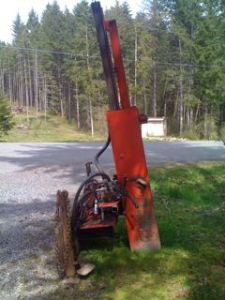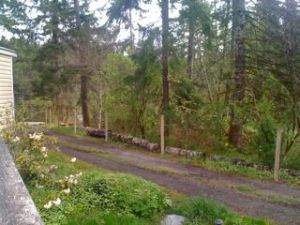It was an exciting couple of days here this past week when the fencing guys showed up to install our new fencing. After going over many possibilities we decided to have professionals come and do the side of the pig pasture that lay along the property line with our neighbour. We chose a woven wire livestock fence, with 6-inch diameter round cedar posts and wire mesh that has smaller (rectangular) holes near the bottom and larger ones near the top. This 300-foot section ran over some uneven ground and, as it turned out, required the removal of a few small trees. We could never have done a proper job of this ourselves, not having any earthmoving equipment. The fencing guys arrived with a nifty little Bobcat – well, actually it’s the biggest Bobcat you can get, so we were told – and we were fully impressed with the strength and versatility of this little machine.
The first thing they did was create a path about 10 feet wide along the property boundary so they could properly sight the line. The fence would go about 4 – 6 inches inside this boundary so that it was “all ours”, legally speaking. Then they smoothed the grade a bit in preparation for the posts. Part of this process required them to fill in a low-lying boggy area. This was a bonus since they used a huge pile of wood debris sitting nearby that was leftover from when the utilities crews came by to clear the right-of-way several years ago. They used it to fill in the low-lying area, then topped it off with dirt and ran over it until it was pretty solid. What a difference! And it was nice to finally be able to reach the gate (which you can’t see in this photo – it’s beside the utility pole) without being ripped apart by nasty thorny bushes.
Ditto with the bottom short side of the pasture, another section that was full of thorny bushes, piles of logs and small poles, and really messy-looking. Hopefully the pigs will take care of the mess on the left side of the photo. We’ll get to the mess on the right when the budget next allows.
It was neat watching them put the posts in. I’ve done my fair share of digging in our rocky soil and I can tell you it is back-breaking work. Even a brand-new sharpened shovel will go in maybe 2 – 4 inches before hitting a rock. Hand-held post hole scoopers are useless and even hand-held powered augers don’t work – hit a big enough rock and the thing could throw you off your feet. We assumed the pros would use an auger mounted on a tractor, but our guys showed up with this nifty post-pounding attachment.
This made quick work of installing posts – no holes to be dug! – and allowed for the operator to adjust for level as the posts were going in. It was for this reason that we decided to have him install posts for us along the other three sides of the pig pasture: we got the posts at the contractor’s cost and it was only $5 more to have them pounded in.
As someone who has personal experience with digging in our rocky soil, this was as sweet a bargain as I could behold, and *definitely* worth the hours and hours of hard labour it would cost us to do it ourselves. It also looks much nicer than the cheap plastic posts we used for last year’s electric fence. To top it off, when the fence guy heard we would be running electric tape along the posts he suggested we double-space them. This cut the cost in half, it’s fully sufficient for electric tape fencing, and when we are ready to do a proper woven wire fence we merely need to put posts in-between and they’d all be the right distance apart. We really appreciated this advice.
The top half of the pasture is almost a right triangle, with a very short top section joining the two long sides. The long side that isn’t on the property boundary follows the curve of our driveway. We chose this because we thought it would look nice to have fencing running alongside the driveway, but mostly because this required no clearing (other than moving aside the logs I so diligently rolled into place by hand last year!). It will allow the pigs access to the wooded area within, which we think will make them happy (pigs are forest creatures, after all). After following the driveway the line then continues alongside the “roadway” that leads down into the undeveloped part of the property and was rather loosely defined until the posts went up.
The total area of the pasture is approximately 1/2 acre, or around 20,000 square feet. There’s still some work to do clearing out the area: our fire pit will have to be moved, as will a large pile of firewood, and my compost bin and some other piles of wood debris (while we had the Bobcat here, we had him move one large pile for us). Husband will be stringing the electric wire some time soon and running a line to the garage for power. Finally, the pig shelter we built last year is going to be moved uphill a ways and turned towards the southeast so they can get the early sun to warm them in the mornings. We’re going to replace the roof (which was recycled from an old greenhouse on the property) with a metal shed roof from which we will collect rainwater for the pigs to drink. They arrive in about 5 weeks so we’ll definitely be ready by then, and very much looking forward to having critters around again.








Posted by The Dream: revisited « Rural Aspirations on March 21, 2012 at 8:24 pm
[…] have a fenced pasture/paddock area for the pigs we raise each summer (about 1/2 an acre), and we’ll soon be adding a free-ranging area for […]